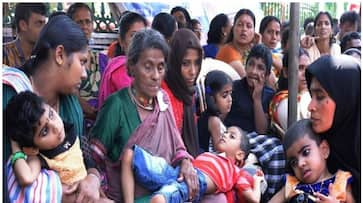The endosulfan victims, who had been carrying out a hunger strike in front of the secretariat for the last four days, ended the protest after an hour-long discussion with chief minister Pinarayi Vijayan.
Thiruvananthapuram: After an hour-long discussion with chief minister Pinarayi Vijayan, the endosulfan protestors ended their four-day strike.
According to reports, the state government decided to include all victims to the list made to provide compensation and other aids without any discrimination on the basis of panchayath limits. A district collector will be appointed to evaluate the situation and update the list.
The victims had been protesting in front of the secretariat under the leadership of social activist Daya Bai. The victims from Kasaragod, Kerala, began an indefinite fast in front of the secretariat, Thiruvananthapuram, on January 30. The main demand of theirs is speedy disbursal of compensation and rehabilitation.
Chief minister’s private secretary MV Jayarajan clarified that all 1905 people will be included in the 2017 list of victims and will be provided with necessary help. The protesters had staged a march on Sunday morning when their demands were denied initially.
The victims earlier had staged many rallies, sit-in protests and hunger strikes in the state capital. In the years 2012, 2013, 2014, 2016 and 2018, the victims protested to seek the attention of the ruling government.
People in Kasaragod district were exposed to the insecticide endosulfan between the year 1975 and 2000. It is alleged that the public sector plantation corporation of Kerala sprayed the chemical aerially on its 12,000 acre of cashew estates.
More than 1,000 people died then. Since then, hundreds of children were born with congenital disabilities, epilepsy, cerebral palsy, hydrocephalus, diseases of the nervous system and severe physical and mental disabilities.
The Plantation Corporation of Kerala stopped spraying endosulfan in 2001, but its impact is still being felt in Kasargod – babies continue to be born with genetic disorders and physical deformities. This is why environmental activists call it the biggest pesticide tragedy in India.
Last Updated Feb 3, 2019, 6:50 PM IST









![Salman Khan sets stage on fire for Anant Ambani, Radhika Merchant pre-wedding festivities [WATCH] ATG](https://static-gi.asianetnews.com/images/01hr1hh8y86gvb4kbqgnyhc0w0/whatsapp-image-2024-03-03-at-12-24-37-pm_100x60xt.jpg)
![Pregnant Deepika Padukone dances with Ranveer Singh at Anant Ambani, Radhika Merchant pre-wedding bash [WATCH] ATG](https://static-gi.asianetnews.com/images/01hr1ffyd3nzqzgm6ba0k87vr8/whatsapp-image-2024-03-03-at-11-45-35-am_100x60xt.jpg)


